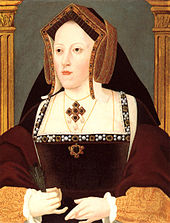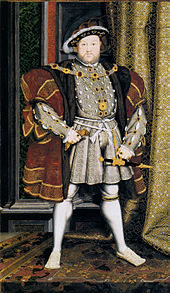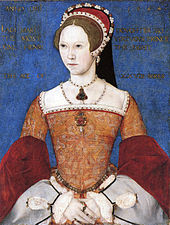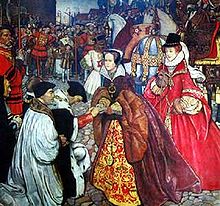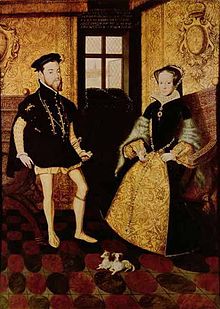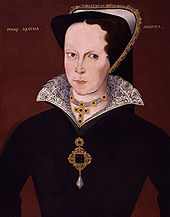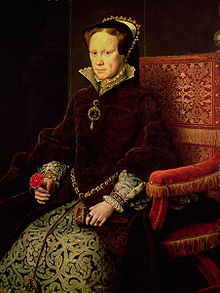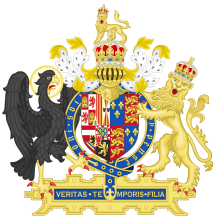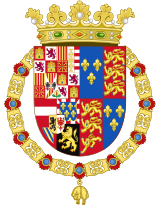- Mary I of England
-
Mary I 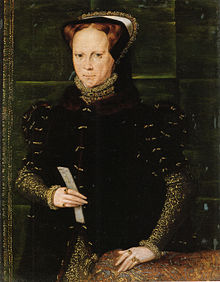
Queen Mary by Hans Eworth Queen of England and Ireland (more...) Reign 19 July 1553 – 17 November 1558[1] Coronation 1 October 1553 Predecessor Jane (disputed) or Edward VI Successor Elizabeth I Co-monarch Philip Queen consort of Spain Tenure 16 January 1556 – 17 November 1558 Spouse Philip II of Spain House House of Tudor Father Henry VIII of England Mother Catherine of Aragon Born 18 February 1516
Palace of Placentia, GreenwichDied 17 November 1558 (aged 42)
St James's Palace, LondonBurial 14 December 1558[2]
Westminster Abbey, LondonSignature 
Religion Roman Catholicism Mary I (18 February 1516 – 17 November 1558) was queen regnant of England and Ireland from July 1553 until her death.
She was the only surviving child born of the ill-fated marriage of Henry VIII and his first wife Catherine of Aragon. Her younger half-brother, Edward VI, succeeded Henry in 1547. By 1553, Edward was mortally ill and because of religious differences between them, he attempted to remove Mary from the line of succession. On his death, their cousin Lady Jane Grey was at first proclaimed queen. Mary assembled a force in East Anglia, and successfully deposed Jane, who was ultimately beheaded. In 1554, Mary married Philip of Spain, and as a result became queen consort of Habsburg Spain on his accession in 1556.
As the fourth crowned monarch of the Tudor dynasty, Mary is remembered for her restoration of Roman Catholicism after the short-lived Protestant reign of her brother. During her five year reign, she had over 280 religious dissenters burned at the stake in the Marian Persecutions. Her Protestant opponents gave her the sobriquet of "Bloody Mary". Her re-establishment of Roman Catholicism was reversed after her death in 1558 by her successor and younger half-sister, Elizabeth I.
Contents
Birth and family
Mary was the only child of King Henry VIII of England and his first wife Catherine of Aragon to survive infancy. Her mother had many miscarriages,[3] and Mary had been preceded by a stillborn sister and three short-lived brothers, including Henry, Duke of Cornwall.[4] Through her mother, she was a granddaughter of King Ferdinand II of Aragon and Queen Isabella I of Castile. She was born at the Palace of Placentia in Greenwich, London, and was baptised three days later at the Church of the Observant Friars.[5] Her godparents included her great-aunt the Countess of Devon, Lord Chancellor Thomas Wolsey, and the Duchess of Norfolk.[6] The King's cousin once removed Margaret Pole, 8th Countess of Salisbury, stood sponsor for Mary's confirmation, which was held immediately after the baptism.[7] The following year, Mary became a godmother herself when she was named as one of the sponsors of her cousin Frances Brandon.[8] In 1520, the Countess of Salisbury was appointed as Mary's governess.[9] Sir John Hussey, later Lord Hussey, was her chamberlain, and his wife, Lady Anne, daughter of George Grey, 2nd Earl of Kent, was one of Mary's attendants.[10]
Education and marriage plans
Mary was a precocious child.[11] In July 1520, when scarcely four and a half years old, she entertained a visiting French delegation with a performance on the virginals (a type of harpsichord).[12] It was said that the princess was very beautiful in her youth, as a child and young woman. A great part of her early education came from her mother, who consulted the Spanish humanist Juan Luis Vives for advice.[13] By the age of nine, Mary could read and write Latin.[14] She studied Greek, music, and dance. Henry VIII doted on his daughter and boasted to the Venetian ambassador Sebastian Giustiniani, "This girl never cries";[15] he sometimes showed delight in her developing musical skills.[16] Despite this obvious affection, Henry was deeply disappointed that his marriage had produced no sons.
By the time Mary was nine years, it was apparent that her mother would have no more children, and that likely Henry would have no legitimate male heir. In 1525, Henry sent Mary to the border of Wales to preside, presumably in name only, over the Council of Wales and the Marches.[17] She was given her own court based at Ludlow Castle and many of the Royal Prerogatives normally reserved for the Prince of Wales. Vives and others called her the Princess of Wales, although she was never technically invested with the title.[18]
 Portrait miniature of Mary at the time of her engagement to Charles V. She is wearing a square brooch inscribed with "The Emperour".[19]
Portrait miniature of Mary at the time of her engagement to Charles V. She is wearing a square brooch inscribed with "The Emperour".[19]
Throughout Mary's childhood, Henry negotiated potential future marriages for her. When she was only two years old she was promised to the Dauphin, the infant son of King Francis I of France, but after three years the contract was repudiated.[20] In 1522, at the age of six, she was instead contracted to marry her 22-year-old first cousin, the Holy Roman Emperor Charles V.[21] However, within a few years, the engagement was broken off by Charles with Henry's agreement.[22] Cardinal Wolsey, Henry's chief adviser, then resumed marriage negotiations with the French, and Henry suggested that Mary marry the Dauphin's father, King Francis I himself, who was eager for an alliance with England.[23] A marriage treaty was signed which provided that Mary marry either Francis I or his second son Henry, Duke of Orleans,[24] but Wolsey then secured an alliance with France without the marriage.
Adolescence
Meanwhile, the marriage of Mary's parents was in jeopardy. Disappointed at the lack of a male heir, and eager to re-marry, Henry attempted to have his marriage to Catherine annulled, but Pope Clement VII refused his requests. Henry claimed, citing biblical passages (Leviticus 20:21), that his marriage to Catherine was unclean because she was previously married, briefly at age 16, to his late brother Arthur. Catherine claimed that her marriage to Arthur was never consummated, and so was not a valid marriage. Indeed, her first marriage had been annulled by a previous Pope, Julius II, on that basis. Clement may have been reluctant to act because he was influenced by Charles V, Catherine's nephew and Mary's former betrothed, whose troops had surrounded and occupied Rome in the War of the League of Cognac.[25]
From 1531, Mary was often sick with irregular menstruation and depression, although it is not clear whether this was caused by stress, puberty or a more deep-seated disease.[26] She was not permitted to see her mother, who was sent by Henry to live away from court.[27] In 1533, Henry married Anne Boleyn, who was pregnant with his child. Shortly thereafter, Thomas Cranmer, the Archbishop of Canterbury, formally declared the marriage with Catherine void, and the marriage to Anne valid. Henry broke with the Roman Catholic Church and declared himself head of the Church of England and the Church of Ireland. Catherine was demoted to Dowager Princess of Wales (a title she would have held as the widow of Arthur), and Mary was deemed illegitimate. She was styled "The Lady Mary" rather than Princess, and her place in the line of succession was transferred to her newborn half-sister, Elizabeth, Anne's daughter.[28] Mary's own household was dissolved;[29] she was expelled from Court; her servants (including the Countess of Salisbury and Mary's favourite maid Susan Clarencieux) were dismissed from her service, and in December 1533 she was sent to serve as a lady-in-waiting to Elizabeth.[30]
Mary determinedly refused to acknowledge that Anne was the Queen or that Elizabeth was a princess, further enraging the King.[31] Under strain and with her movements restricted, Mary was frequently ill, which the royal physician attributed to her "ill treatment".[32] Circumstances between Mary and her father worsened; they did not speak to each other for three years.[33] Although both she and her mother were ill, Mary was refused permission to visit Catherine.[34] When Catherine died in 1536, Mary was "inconsolable".[35] Catherine was interred in Peterborough Cathedral while Mary grieved in semi-seclusion at Hunsdon in Hertfordshire.[36]
Womanhood
In 1536, Anne Boleyn fell from the King's favour and was beheaded. Elizabeth, like Mary, was downgraded to the status of Lady and removed from the line of succession.[37] Within two weeks of Anne's execution, Henry married Jane Seymour. Queen Jane urged her husband to make peace with Mary.[38] Henry insisted that Mary recognise him as head of the Church of England, repudiate papal authority, acknowledge that the marriage between her parents was unlawful, and accept her own illegitimacy. She attempted to reconcile with him by submitting to his authority as far as "God and my conscience" permitted, but she was eventually bullied into signing a document agreeing to all of Henry's demands.[39] Reconciled with her father, Mary resumed her place at court.[40] Rebels in the North of England, including Lord Hussey, Mary's former chamberlain, campaigned against Henry's religious reforms, and one of their demands was that Mary be made legitimate. The rebellion, known as the Pilgrimage of Grace, was ruthlessly suppressed.[41] Along with other rebels, Hussey was executed.
The following year, 1537, Queen Jane died after giving birth to a son, Edward. Mary was made godmother to her half-brother Edward and acted as chief mourner at the Queen's funeral.[42] Henry granted her a household (which included the reinstatement of Mary's favourite, Susan Clarencieux), and Mary was permitted to reside in royal palaces. Her privy purse expenses for nearly the whole of this period have been published and show that Hatfield House, the Palace of Beaulieu (also called Newhall), Richmond and Hunsdon were among her principal places of residence. Her expenses included fine clothes and gambling, which was one of her favourite pastimes.[43] She was courted by Duke Philip of Bavaria, but Philip was Lutheran and his suit for her hand was unsuccessful.[44]
Over 1539, the King's chief minister, Thomas Cromwell, negotiated a potential alliance with the Duchy of Cleves. Suggestions that Mary marry the Duke of Cleves, who was the same age as her, came to nothing, but a match between Henry and the Duke of Cleves' sister Anne was agreed.[45] When the King saw Anne for the first time in late December 1539, a week before the scheduled wedding, he did not find her attractive but was unable, for diplomatic reasons and in the absence of a suitable pretext, to cancel the marriage.[46] Cromwell fell from favour and was arrested for treason in June 1540; one of the unlikely charges against him was that he had plotted to marry Mary himself.[47] Anne consented to the annulment of the marriage, which had not been consummated, and Cromwell was beheaded.[48]
In 1541, Henry had Mary's old governess and godmother, Margaret Pole, 8th Countess of Salisbury, executed on the pretext of a Catholic plot, in which Margaret's son (Reginald Pole) was implicated. Her executioner was "a wretched and blundering youth" who "literally hacked her head and shoulders to pieces".[49] In 1542, following the execution of Henry's fifth wife, Catherine Howard, the unmarried Henry invited Mary to oversee the royal Christmas festivities "in default of a Queen". At court, while her father was between marriages and without a consort, Mary acted as hostess.[50] In 1543, Henry married his sixth and last wife, Catherine Parr, who was able to bring the family closer together.[51] Henry returned Mary and Elizabeth to the line of succession, through the Act of Succession 1543, placing them after Edward. However, both women remained legally illegitimate.[52]
In 1547, Henry died and Edward succeeded as Edward VI. Mary inherited estates in Norfolk, Suffolk and Essex, and was granted Hunsdon and Beaulieu as her own.[53] Since Edward was still a child, rule passed to a regency council dominated by Protestants, who attempted to establish their faith throughout the country. For example, the Act of Uniformity 1549 prescribed Protestant rites for church services, such as the use of Thomas Cranmer's new Book of Common Prayer. Mary remained faithful to Roman Catholicism, and appealed to her cousin Charles V for protection so that she was able to practise her religion privately in her own chapel.[54]
For most of Edward's reign, Mary remained on her own estates, and rarely attended court.[55] A plan between May and July 1550 to smuggle her out of England to the safety of the European mainland came to nothing.[56] Religious differences between Mary and Edward continued. When Mary was in her thirties, she attended a reunion with Edward and Elizabeth for Christmas 1550, where 13-year-old Edward embarrassed Mary, and reduced both her and himself to tears in front of the court, by publicly reproving her for ignoring his laws regarding worship.[57] Mary repeatedly refused Edward's demands that she abandon Catholicism, and Edward repeatedly refused to drop his demands.[58]
Accession
On 6 July 1553, at the age of 15, Edward VI died from a lung infection, possibly tuberculosis.[59] Edward did not want the crown to go to Mary, who he feared would restore Catholicism and undo his reforms, as well as those of Henry VIII. For this reason, he planned to exclude her from the line of succession. However, his advisors told him that he could not disinherit only one of his sisters, but that he would have to disinherit Elizabeth as well, even though she embraced the Church of England. Guided by John Dudley, 1st Duke of Northumberland, and perhaps others, Edward excluded both of his sisters from the line of succession in his will.[60]
In contradiction of the Succession Act, which restored Mary and Elizabeth to the line of succession, Edward VI and his advisors devised that he be succeeded by Dudley's daughter-in-law Lady Jane Grey, the granddaughter of Henry VIII's younger sister Mary Tudor, Queen of France. Lady Jane's mother was Frances Brandon, who was Mary's cousin and goddaughter. Just before Edward VI's death, Mary was summoned to London to visit her dying brother. She was warned, however, that the summons was a pretext on which to capture her and thereby facilitate Lady Jane's accession to the throne.[61] Instead of heading to London from her residence at Hunsdon, Mary fled into East Anglia, where she owned extensive estates and Dudley had ruthlessly put down Kett's Rebellion. Many adherents to the Catholic faith, opponents of Dudley, lived there.[62] On 9 July, from Kenninghall, Norfolk, she wrote to the privy council with orders for her proclamation as Edward's successor.[63]
 Mary by Hans Eworth, 1554. She wears a jewelled pendant bearing the pearl known as La Peregrina set beneath two diamonds.
Mary by Hans Eworth, 1554. She wears a jewelled pendant bearing the pearl known as La Peregrina set beneath two diamonds.
On 10 July 1553, Lady Jane was proclaimed Queen by Dudley and his supporters, and on the same day Mary's letter to the council arrived in London. By 12 July, Mary and her supporters had assembled a military force at Framlingham Castle, Suffolk.[64] Dudley's support collapsed, and Mary's grew.[65] Jane was deposed on 19 July.[66] She and Dudley were imprisoned in the Tower of London. Mary rode triumphantly into London on 3 August 1553 on a wave of popular support. She was accompanied by her half-sister Elizabeth, and a procession of over 800 other nobles and gentlemen.[67]
One of Mary's first actions as Queen was to order the release of the Roman Catholic Duke of Norfolk and Stephen Gardiner from imprisonment in the Tower of London, as well as her kinsman Edward Courtenay.[68] Mary understood that the young Lady Jane was essentially a pawn in Dudley's scheme, and Dudley was the only conspirator of rank executed for high treason in the immediate aftermath of the coup. Lady Jane and her husband, Lord Guildford Dudley, though found guilty, were kept under guard in the Tower rather than executed, while Lady Jane's father, Henry Grey, 1st Duke of Suffolk, was released.[69] Mary was left in a difficult position, as almost all the Privy Counsellors had been implicated in the plot to put Jane on the throne.[70] She appointed Gardiner to the council and made him both Bishop of Winchester and Lord Chancellor, offices he held until his death in November 1555. Susan Clarencieux became Mistress of the Robes.[71] On 1 October 1553, Gardiner formally crowned Mary Queen of England at Westminster Abbey.[72]
Reign
Spanish marriage
At age 37, Mary turned her attention to finding a husband and producing an heir, thus preventing the Protestant Elizabeth (still her successor under the terms of Henry VIII's will and the Act of Succession of 1544), from succeeding to the throne. Edward Courtenay and Reginald Pole were both mentioned as prospective suitors, but her cousin Charles V suggested she marry his only son, Prince Philip of Spain.[73] Philip had a son from a previous marriage, and was heir apparent to vast territories in Continental Europe and the New World. It is said[by whom?] that upon viewing the full-length portrait of Philip by Titian, now in the Prado,[74] which was sent to her in September 1553,[75] Mary declared herself to be in love with him.
Lord Chancellor Gardiner and the House of Commons unsuccessfully petitioned her to consider marrying an Englishman, fearing that England would be relegated to a dependency of the Habsburgs.[76] The marriage was as unpopular in England as it was in Spain. Philip's courtiers and servants had no desire to follow him to a "chilly land of barbarous heretics", whereas his other subjects did not desire to see him go. Those who were aware of the terms of the marriage thought that Philip's honour had been disparaged. It is probable that Philip himself felt so;[77] Gardiner and his allies opposed it on the basis of patriotism, while Protestants were motivated by a fear of Catholicism.[78] When Mary insisted on marrying Philip, insurrections broke out. Thomas Wyatt the younger led a force from Kent to depose Mary in favour of Elizabeth, as part of a wider conspiracy now known as Wyatt's rebellion, which involved the Duke of Suffolk, the father of Lady Jane.[79] Mary declared publicly that she would summon Parliament to discuss the marriage, and if Parliament decided that the marriage was not to the advantage of the kingdom, she would refrain from pursuing it.[80] On reaching London, Wyatt was defeated and captured. Wyatt, the Duke of Suffolk, his daughter Lady Jane, and her husband Guildford Dudley, were executed. Courtenay, who was implicated in the plot, was imprisoned, and then exiled. Elizabeth, though protesting her innocence in the Wyatt affair, was imprisoned in the Tower of London for two months, then was put under house arrest at Woodstock Palace.[81]
Mary was—excluding the brief, disputed reigns of Jane and Empress Matilda—England and Ireland's first Queen regnant. Further, under the English common law doctrine of jure uxoris, the property and titles belonging to a woman became that of her husband upon marriage, and it was feared that any man she married would thereby become King of England and Ireland in fact and in name.[82] While Mary's grandparents, Ferdinand and Isabella, had retained sovereignty of their own realms during their marriage, there was no precedent to follow in England.[83] Under the terms of the marriage treaty, Philip was to be styled "King of England", all official documents (including Acts of Parliament) were to be dated with both their names, and Parliament was to be called under the joint authority of the couple, for Mary's lifetime only. Coins were to show the heads of both Mary and Philip. England would not be obliged to provide military support to Philip's father in any war, and Philip could not act without his wife's consent or appoint foreigners to office in England.[84] Philip was unhappy at the conditions imposed, but his view of the affair was entirely political, and he was ready to agree for the sake of securing the marriage.[85] He had no amorous feelings toward Mary and sought the marriage for its political and strategic gains; he wrote to a correspondent in Brussels, "the marriage was concluded for no fleshly consideration, but to remedy the disorders of this kingdom and to preserve the Low Countries."[86]
To elevate his son to Mary's rank, Emperor Charles V ceded the crown of Naples, as well as his claim to the Kingdom of Jerusalem, to Philip. Therefore, Mary became Queen of Naples and titular Queen of Jerusalem upon marriage.[87] Their marriage at Winchester Cathedral on 25 July 1554 took place just two days after their first meeting.[88] Philip could not speak English, and so they spoke in a mixture of Spanish, French, and Latin.[89]
Pregnancy
In September 1554, Mary stopped menstruating. She gained weight, and felt nauseated in the mornings. Virtually the whole court, including her doctors, thought she was pregnant.[90] In the last week of April 1555, Elizabeth was released from house arrest, and called to court as a witness to the birth, which was expected imminently.[91] According to Giovanni Michiel, the Venetian ambassador, Philip may have planned to marry Elizabeth in the event of Mary's death in childbirth,[92] but in a letter to his brother-in-law, Maximilian of Austria, Philip expressed uncertainty as to whether his wife was pregnant.[93]
Thanksgiving services in the diocese of London were held at the end of April after false rumours that Mary had given birth to a son spread across Europe.[94] Through May and June, the apparent delay in delivery fed gossip that Mary was not pregnant.[95] Susan Clarencieux revealed her doubts to the French ambassador, Antoine de Noailles.[96] Mary continued to exhibit signs of pregnancy until July 1555, when her abdomen receded. There was no baby. Michiel dismissively ridiculed the pregnancy as more likely to "end in wind rather than anything else".[97] It was most likely a phantom pregnancy, perhaps induced by Mary's overwhelming desire to have a child.[98] In August, soon after the disgrace of the false pregnancy, Philip left England to command his armies against France in Flanders.[99] Mary was heartbroken and fell into a deep depression. Michiel was touched by the Queen's grief; he wrote she was "extraordinarily in love" with her husband, and was disconsolate at his departure.[100]
Elizabeth remained at court until October, apparently restored to favour.[101] In the absence of any children, Philip was concerned that after Mary and Elizabeth, one of the next claimants to the English throne was the Queen of Scotland, who was betrothed to the Dauphin of France. Philip persuaded Mary that Elizabeth should marry his cousin, Emmanuel Philibert, Duke of Savoy, to secure the Catholic succession and preserve the Habsburg interest in England, but Elizabeth refused to comply and parliamentary consent was unlikely.[102]
Religious policy
In the month following her accession, Mary issued a proclamation that she would not compel any of her subjects to follow her religion, but by the end of September leading reforming churchmen, such as John Bradford, John Rogers, John Hooper, Hugh Latimer and Thomas Cranmer were imprisoned.[103] Mary's first Parliament, which assembled in early October 1553, declared the marriage of Henry and Catherine valid, and abolished Edward's religious laws.[104] Church doctrine was restored to the form it had taken in the 1539 Six Articles, which, for example, re-affirmed clerical celibacy. Married priests were deprived of their benefices.[105]
Mary had always rejected the break with Rome instituted by her father and the establishment of Protestantism by Edward VI. She and her husband wanted England to reconcile with Rome. Philip persuaded Parliament to repeal the Protestant religious laws passed by Mary's father, thus returning the English church to Roman jurisdiction. Getting agreement took many months, and Mary had to make a major concession: the monastery lands confiscated under Henry were not returned to the church but remained in the hands of the new landowners, who were very influential.[106] Pope Julius III approved the deal in 1554; the same year the Heresy Acts were revived.
Under the Heresy Acts, numerous Protestants were executed in the Marian Persecutions. Many rich Protestants, including John Foxe, chose exile, and around 800 left the country.[107] The first executions occurred over a period of five days in early February 1555: John Rogers on 4 February, Laurence Saunders on 8 February, and Rowland Taylor and John Hooper on 9 February.[108] The imprisoned Archbishop of Canterbury Thomas Cranmer was forced to watch Bishops Ridley and Latimer being burned at the stake. Cranmer recanted, repudiated Protestant theology, and rejoined the Catholic faith.[109] Under the normal process of the law, he should have been absolved as a repentant. Mary, however, refused to reprieve him. On the day of his burning, he dramatically withdrew his recantation.[110] All told 283 were executed, most by burning.[111] The burnings proved so unpopular, that even Alfonso de Castro condemned them,[112] and Philip's advisor, Simon Renard, warned him that such "cruel enforcement" could "cause a revolt".[113] Mary persevered with the policy, which continued until her death and exacerbated anti-Catholic and anti-Spanish feeling among the English people.[114] The victims of the persecutions became lauded as martyrs.[115]
Reginald Pole, the son of Mary's executed governess, Margaret Pole, 8th Countess of Salisbury, and once considered a suitor, arrived as papal legate in November 1554.[116] He was ordained a priest and appointed as Archbishop of Canterbury immediately after Cranmer's death in March 1556.[117][118] Mary came to rely on him for advice.
Foreign policy
Henry VIII's creation of the Kingdom of Ireland in 1542 was not recognised by Europe's Catholic powers. In 1555 Mary obtained a papal bull confirming that she and Philip were the monarchs of Ireland, and thereby the Church accepted the personal link between the kingdoms of Ireland and England. Furthering the Tudor conquest of Ireland, the midlands counties of Laois and Offaly were shired and named after the new monarchs respectively as "Queen's County" and "King's County". Their principal towns were respectively named Maryborough (now Portlaoise) and Philipstown (now Daingean). Under Mary's reign, English colonists were settled in the Irish Midlands to reduce the attacks on the Pale (the colony around Dublin).
In January 1556, Mary's father-in-law abdicated and Philip became King of Spain, with Mary as his consort. They were still apart; Philip was declared King in Brussels, but Mary stayed in England. Philip negotiated an unsteady truce with the French in February 1556. The following month, the French ambassador in England, Antoine de Noailles, was implicated in a plot against Mary when Sir Henry Dudley, a second cousin of the executed Duke of Northumberland, attempted to assemble an invasion force in France. The plot, known as the Dudley conspiracy, was betrayed, and the conspirators in England were rounded up. Dudley remained in exile in France, and Noailles prudently left Britain.[119]
Philip returned to England from March to July 1557 to persuade Mary to support Spain in a renewed war against France. Mary was in favour of declaring war, but her councillors opposed it because French trade would be jeopardised, it contravened the marriage treaty, and a bad economic legacy from Edward VI's reign and a series of poor harvests meant England lacked supplies and finances.[120] War was only declared after Reginald Pole's nephew, Thomas Stafford, invaded England with French help in an attempt to depose Mary.[121] As a result of the war, relations between England and the Papacy became strained, since Pope Paul IV was allied with Henry II of France.[122] In January 1558, French forces took Calais, England's sole remaining possession on the European mainland. Although the territory was financially burdensome, it was an ideological loss that damaged Mary's prestige.[123] Mary later lamented that when she died the words "Philip" and "Calais" would be found inscribed on her heart. England became full of factions and seditious pamphlets of Protestant origin inflaming the country against the Spaniards.
Commerce and revenue
The years of Mary's reign were consistently wet. The persistent rain and subsequent flooding led to famine.[124] Another problem was the decline of the Antwerp cloth trade. Despite Mary's marriage to Philip, England did not benefit from their enormously lucrative trade with the New World. The Spanish guarded their trading revenue jealously, and Mary could not condone illegitimate trade (in the form of piracy) because she was married to a Spaniard. In an attempt to increase trade and rescue the English economy, Mary continued Northumberland's policy of seeking out new commercial opportunities. She granted a royal charter to the Muscovy Company, whose first governor was Sebastian Cabot,[125] and commissioned a world atlas from Diogo Homem.[126] Adventurers like John Lok and William Towerson sailed south in an attempt to develop links with the coast of Africa.[127]
Financially, Mary tried to reconcile a modern form of government—with correspondingly higher spending—with a medieval system of collecting taxation and dues.[128] A failure to apply new tariffs to new forms of imports meant that a key source of revenue was neglected. To solve this problem, Mary's government published the "Book of Rates" (1558), which listed the tariffs and duties for every import. This publication was not extensively reviewed until 1604.[129] Mary appointed William Paulet, 1st Marquess of Winchester, as Surveyor of Customs and assigned him to oversee the revenue collection system.
Mary continued the currency reform overseen by Thomas Gresham, started in 1551, to counteract the dramatic devaluation that had characterised the 1540s and early 1550s. However, these measures were largely unsuccessful.
Death
After Philip's visit in 1557, Mary thought herself pregnant again with a baby due in March 1558.[130] She decreed in her will that her husband be the regent during the minority of her child.[131] However, no child was born, and Mary was forced to accept that Elizabeth was her lawful successor.[132]
Mary was weak and ill from May 1558,[133] and died aged 42 at St. James's Palace during an influenza epidemic that claimed the life of Reginald Pole later the same day, 17 November 1558. She was in pain, possibly from ovarian cysts or uterine cancer.[134] She was succeeded by her half-sister, who became Elizabeth I. Philip, who was in Brussels, wrote in a letter, "I felt a reasonable regret for her death."[135]
Although her will stated that she wished to be buried next to her mother, Mary was interred in Westminster Abbey on 14 December in a tomb she eventually shared with Elizabeth. The Latin inscription on their tomb, Regno consortes & urna, hic obdormimus Elizabetha et Maria sorores, in spe resurrectionis (affixed there by James VI of Scotland when he succeeded Elizabeth as King James I of England) translates to "Consorts in realm and tomb, here we sleep, Elizabeth and Mary, sisters, in hope of resurrection". The Latin plays on the multiple meanings of consorts, which can mean either sibling or sharer in common.
Legacy
At her funeral service John White, Bishop of Winchester, praised Mary: "She was a King's daughter; she was a King's sister; she was a King's wife. She was a Queen, and by the same title a King also."[136] She was the first woman to successfully claim the throne of England, despite competing claims and determined opposition, and enjoyed popular support and sympathy during the earliest parts of her reign, especially from the Roman Catholic population. However, her marriage to Philip was unpopular among her subjects, and her religious policies resulted in deep-seated resentment.[137] The failed harvests, poor weather and military losses of her reign increased public discontent. Philip spent most of his time abroad, while his wife remained in England, leaving her depressed at his absence and undermined by their inability to have children. After Mary's death, he sought to marry Elizabeth, but she refused him.[138] Thirty years later, Philip sent the Spanish Armada to overthrow Elizabeth, without success.
By the seventeenth century, Mary's persecution of Protestants had led them to call her Bloody Mary.[139] John Knox attacked her in The First Blast of the Trumpet Against the Monstrous Regimen of Women, published in 1558, and she was prominently featured and vilified in Foxe's Book of Martyrs, published by John Foxe in 1563, six years after Mary's death. Subsequent editions of the book remained popular with Protestants throughout the following centuries, and helped shape perceptions of her as a bloodthirsty tyrant.[140]
Titles, style and arms
Like Henry VIII and Edward VI, Mary used the style "Majesty", as well as "Highness" and "Grace". "Majesty", which Henry VIII first used consistently, did not become exclusive until the reign of Elizabeth I's successor, James I.
When Mary ascended the throne, she was proclaimed under the same official style as Henry VIII and Edward VI: "Mary, by the Grace of God, Queen of England, France and Ireland, Defender of the Faith, and of the Church of England and also of Ireland in Earth Supreme Head" (Latin: Maria Dei Gratia Angliae, Franciae et Hiberniae Regina, Fidei Defensor, et in terra ecclesiae Anglicanae et Hibernicae supremum caput). The "supremacy phrase" at the end of the style was repugnant to Mary's Catholicism; from 1554 onwards, she omitted the phrase without statutory authority, which was not retroactively granted by Parliament until 1555.[141]
Under Mary's marriage treaty with Philip, the couple were jointly styled Queen and King. Philip became Mary's co-ruler, while she became merely his consort as Duchess of Brabant, Limburg, Lothier, Guelders and Luxemburg, Marquise of Namur, Countess Palatine of Burgundy and Countess of Artois, Flanders, Charolais, Hainaut, Zutphen, Holland and Zeeland.
The official joint style reflected not only Mary's but Philip's dominions and claims; it was "Philip and Mary, by the grace of God, King and Queen of England, France, Naples, Jerusalem, and Ireland, Defenders of the Faith, Princes of Spain and Sicily, Archdukes of Austria, Dukes of Milan, Burgundy and Brabant, Counts of Habsburg, Flanders and Tyrol".[87] This style, which had been in use since 1554, was replaced when Philip inherited the Spanish Crown in 1556 with "Philip and Mary, by the Grace of God King and Queen of England, Spain, France, both the Sicilies, Jerusalem and Ireland, Defenders of the Faith, Archdukes of Austria, Dukes of Burgundy, Milan and Brabant, Counts of Habsburg, Flanders and Tyrol".[142]
Mary I's arms were the same as those used by all her predecessors since Henry IV: Quarterly, Azure three fleurs-de-lys Or [for France] and Gules three lions passant guardant in pale Or [for England]. Sometimes, her arms were impaled (depicted side-by-side) with those of her husband. She adopted "Truth, the Daughter of Time" (Latin: Veritas Temporis Filia) as her personal motto.[143]
Mary's marital title Queen of Spain carried with it, the title "Queen of the Spanish East and West Indies and of the Islands and Mainland of the Ocean Sea". This titulary held by Philip came from his father, her cousin, Charles, under the original form "Rex Hispaniarum et Indiarum" (i.e., King of the Spaniards and the Indians). The shorthand for this is usually rendered as the Viceroyalty of New Spain.
Ancestry
Both Mary and Philip were descended from John of Gaunt, 1st Duke of Lancaster, a relationship which was used to portray Philip as an English king.[144] John had once claimed lands in Spain jure uxoris by the Infanta Constance of Castile. John's Lancastrian descendents in Spain and Portugal honoured the English Royal Family by naming several children Eduardo or Duarte (Edward) after John's father, Edward III of England. Edmund of Langley, 1st Duke of York, from which the Yorkist party derived (as well as her father Henry VIII's maternal line), married Infanta Isabella of Castile, so the Anglo-Castilian connection in right of Portugal had certainly influenced not only Mary's parental background, but her own marriage to Philip, whose own heritage was not simply Habsburg (which at that time was novel), but Burgundian and important for the Yorkist factor, as well as the Anglo-French wars in general.
Ancestors of Mary I of England 16. Owen Tudor 8. Edmund Tudor, 1st Earl of Richmond 17. Catherine of Valois 4. Henry VII of England 18. John Beaufort, 1st Duke of Somerset 9. Lady Margaret Beaufort 19. Margaret Beauchamp of Bletso 2. Henry VIII of England 20. Richard Plantagenet, 3rd Duke of York 10. Edward IV of England 21. Cecily Neville 5. Elizabeth of York 22. Richard Woodville, 1st Earl Rivers 11. Lady Elizabeth Woodville 23. Jacquetta of Luxembourg 1. Mary I of England 24. Ferdinand I of Aragon 12. John II of Aragon 25. Eleanor of Alburquerque 6. Ferdinand II of Aragon 26. Fadrique Enríquez, Count of Melba and Rueda 13. Juana Enríquez 27. Mariana de Córdoba 3. Catherine of Aragon 28. Henry III of Castile 14. John II of Castile 29. Katherine of Lancaster 7. Isabella I of Castile 30. Infante João, Lord of Reguengos 15. Infanta Isabel of Portugal 31. Isabella of Braganza See also
English Royalty House of Tudor 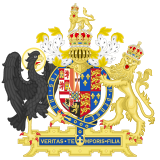
Royal Coat of ArmsHenry VIII Henry, Duke of Cornwall Mary I Elizabeth I Edward VI Mary I House of Habsburg
Spanish lineEmperor Charles V
(King Charles I)Children Philip II of Spain Maria, Holy Roman Empress Joan of Spain Don John (illegitimate) Margaret of Parma (illegitimate) Philip II Children include Carlos, Prince of Asturias Isabella of Spain Catherine, Duchess of Savoy Philip III of Spain Maria of Spain Philip III Children include Anne, Queen of France Philip IV of Spain Maria Ana, Holy Roman Empress Infante Carlos Cardinal-Infante Ferdinand Philip IV Children include Balthasar Charles, Prince of Asturias Maria Theresa, Queen of France Margaret, Holy Roman Empress Charles II of Spain Charles II Notes
- ^ Her half-brother died on 6 July; she was proclaimed his successor in London on 19 July; her regnal years were dated from 24 July (Weir, p. 160).
- ^ The Gentleman's magazine. F. Jefferies. 1886. p. 233.
- ^ Waller, p. 16; Whitelock, p. 8
- ^ Weir, pp. 152–153
- ^ Porter, p. 13; Waller, p. 16; Whitelock, p. 7
- ^ Porter, pp. 13, 37; Waller, p. 17
- ^ Porter, p. 13; Waller, p. 17; Whitelock, p. 7
- ^ Porter, p. 15
- ^ Porter, p. 16; Waller, p. 20; Whitelock, p. 21
- ^ Hoyle, p. 407
- ^ Whitelock, p. 27
- ^ Porter, p. 21
- ^ Porter, p. 30
- ^ Porter, p. 28; Whitelock, p. 27
- ^ Domine Orator, per Deum immortalem, ista puella nunquam plorat, quoted in Whitelock, p. 17
- ^ Farquhar, Michael, A Treasure of Royal Scandals (Penguin Books, New York, 2001, ISBN 0739420259) p. 101
- ^ Porter, pp. 38–39; Whitelock, pp. 32–33
- ^ Waller, p. 23
- ^ Whitelock, p. 23
- ^ Porter, pp. 20–21; Waller, pp. 20–21; Whitelock, pp. 18–23
- ^ Porter, pp. 21–24; Waller, p. 21; Whitelock, p. 23
- ^ Whitelock, pp. 30–31
- ^ Whitelock, pp. 36–37
- ^ Whitelock, pp. 37–38
- ^ Porter, pp. 56, 78; Whitelock, p. 40
- ^ Waller, p. 27
- ^ Porter, p. 76; Whitelock, p. 48
- ^ Porter, p. 92; Whitelock, pp. 55–56
- ^ Porter, p. 92; Whitelock, p. 57
- ^ Whitelock, p. 57
- ^ Porter, pp. 97–101; Whitelock, pp. 55–69
- ^ Dr William Butts, quoted in Waller, p. 31
- ^ Porter, p. 100
- ^ Porter, pp. 103–104; Whitelock, pp. 67–69, 72
- ^ Letter from Emperor Charles V to Empress Isabella, quoted in Whitelock, p. 75
- ^ Porter, p. 107; Whitelock, p. 76–77
- ^ Whitelock, p. 91
- ^ Porter, p. 121; Waller, p. 33; Whitelock, p. 81
- ^ Porter, pp. 119–123; Waller, pp. 34–36; Whitelock, pp. 83–89
- ^ Porter, pp. 119–123; Waller, pp. 34–36; Whitelock, pp. 90–91
- ^ Porter, pp. 124–125
- ^ Porter, pp. 126–127; Whitelock, pp. 95–96
- ^ Porter, pp. 129–132; Whitelock, p. 28
- ^ Porter, pp. 135–136; Waller, p. 39; Whitelock, p. 101
- ^ Whitelock, p. 101
- ^ Whitelock, pp. 103–104
- ^ Whitelock, p. 105
- ^ Whitelock, pp. 105–106
- ^ Contemporary Spanish and English reports, quoted in Whitelock, p. 108
- ^ Waller, p. 37
- ^ Porter, pp. 143–144; Whitelock, p. 110
- ^ Waller, p. 39; Whitelock, p. 112
- ^ Whitelock, p. 130
- ^ Porter, pp. 160–162; Whitelock, pp. 133–134
- ^ Porter, p. 154; Waller, p. 40
- ^ Porter, pp. 169–176; Waller, pp. 41–42; Whitelock, pp. 144–147
- ^ Porter, p. 178; Whitelock, p. 149
- ^ Porter, pp. 179–182; Whitelock, pp. 148–160
- ^ Porter, p. 187
- ^ Porter, pp. 188–189
- ^ Waller, pp. 48–49; Whitelock, p. 165
- ^ Waller, pp. 51–53; Whitelock, p. 165, 138
- ^ Porter, p. 195; Whitelock, p. 168
- ^ Porter, p. 203; Waller, p. 52
- ^ Porter, pp. 213–214; Waller, p. 54; Whitelock, pp. 170–174
- ^ Porter, p. 210; Weir, pp. 159–160
- ^ Waller, pp. 57–59
- ^ Waller, p. 59; Whitelock, p. 181
- ^ Waller, pp. 59–60; Whitelock, pp. 185–186
- ^ Whitelock, p. 182
- ^ Whitelock, p. 183
- ^ Porter, pp. 257–261; Whitelock, pp. 195–197
- ^ Porter, pp. 265–267
- ^ Museo del Prado, Catálogo de las pinturas, 1996, pp. 398–399 (#411), Ministerio de Educación y Cultura, Madrid, ISBN 8487317537
- ^ Porter, p. 310
- ^ Porter, pp. 279–284; Waller, p. 72; Whitelock, pp. 202–209
- ^ Loades, p. 75
- ^ Waller, p. 73
- ^ Porter, pp. 288–299; Whitelock, pp. 212–213
- ^ Porter, p. 300; Waller, pp. 74–75; Whitelock, p. 216
- ^ Porter, pp. 311–313; Whitelock, pp. 217–225
- ^ Waller, pp. 84–85; Whitelock, pp. 202, 227
- ^ Porter, p. 269; Waller, p. 85
- ^ Porter, pp. 291–292; Waller, p. 85; Whitelock, pp. 226–227
- ^ Porter, pp. 308–309; Whitelock, p. 229
- ^ Letter of 29 July 1554, quoted in Porter, p. 320
- ^ a b Porter, pp. 321, 324; Waller, p. 90; Whitelock, p. 238
- ^ Porter, pp. 318, 321; Waller, pp. 86–87; Whitelock, p. 237
- ^ Porter, p. 319; Waller, pp. 87, 91
- ^ Porter, p. 333; Waller, pp. 92–93
- ^ Porter, p. 338; Waller, p. 95; Whitelock, p. 255
- ^ Waller, p. 96
- ^ "The queen's pregnancy turns out not to have been as certain as we thought": Letter of 25 April 1554, quoted in Porter, p. 337 and Whitelock, p. 257
- ^ Waller, p. 95; Whitelock, p. 256
- ^ Whitelock, pp. 257–259
- ^ Whitelock, p. 258
- ^ Waller, p. 97; Whitelock, p. 259
- ^ Porter, pp. 337–338; Waller, pp. 97–98
- ^ Porter, p. 342
- ^ Waller, pp. 98–99; Whitelock, p. 268
- ^ Antoine de Noailles quoted in Whitelock, p. 269
- ^ Whitelock, p. 284
- ^ Whitelock, p. 187
- ^ Waller, p. 65; Whitelock, p. 198
- ^ Porter, p. 241; Whitelock, pp. 200–201
- ^ Porter, p. 331
- ^ Waller, p. 113
- ^ Whitelock, p. 262
- ^ Porter, pp. 355–356; Waller, pp. 104–105
- ^ Waller, pp. 104–105; Whitelock, p. 274
- ^ Duffy, p. 79; Waller, p. 104
- ^ Porter, pp. 358–359; Waller, p. 103; Whitelock, p. 266
- ^ Waller, p. 102
- ^ Waller, pp. 101, 103, 105; Whitelock, p. 266
- ^ See for example, the Oxford Martyrs
- ^ Waller, p. 94
- ^ Porter, p. 357
- ^ Although he had been a cardinal since 22 December 1536, Pole was not ordained until the day of his appointment.
- ^ Porter, pp. 381–387
- ^ Whitelock, p. 288
- ^ Porter, p. 389; Waller, p. 111; Whitelock, p. 289
- ^ Whitelock, pp. 293–295
- ^ Porter, pp. 392–395; Whitelock, pp. 291–292
- ^ Porter, pp. 229, 375; Whitelock, p. 277
- ^ Porter, p. 371
- ^ Porter, p. 373
- ^ Porter, p. 372
- ^ Porter, p. 375
- ^ Porter, p. 376
- ^ Porter, p.398; Waller, pp. 106, 112; Whitelock, p. 299
- ^ Whitelock, pp. 299–300
- ^ Whitelock, p. 301
- ^ Whitelock, p. 300
- ^ Waller, p. 108
- ^ Quoted in Waller, p. 109 and Whitelock, p. 303
- ^ Whitelock, p. 305
- ^ Waller, p. 116
- ^ Porter, p. 400
- ^ Waller, p. 115
- ^ Porter, pp. 361–362, 418; Waller, pp. 113–115
- ^ England: Kings and Queens: 1066–1649. Retrieved 11-03-2010.
- ^ e.g. Waller, p. 106
- ^ Waller, p. 60; Whitelock, p. 310
- ^ Whitelock, p. 242
References
- Duffy, Eamon (2009) Fires of Faith: Catholic England Under Mary Tudor. Yale University Press. ISBN 0300152167
- Hoyle, R. W. (2001) The Pilgrimage of Grace and the Politics of the 1530s. Oxford: Oxford University Press. ISBN 0199259062
- Porter, Linda (2007) Mary Tudor: The First Queen. London: Little, Brown. ISBN 978-0-749-90982-6
- Waller, Maureen (2006) Sovereign Ladies: The Six Reigning Queens of England. New York: St. Martin's Press. ISBN 0312338015
- Weir, Alison (1996) Britain's Royal Families: The Complete Genealogy. London: Pimlico. ISBN 0712674489
- Whitelock, Anna (2009) Mary Tudor: England's First Queen. London: Bloomsbury. ISBN 978-1-408-80078-2
Further reading
- Deary, Terry. "The Terrible Tudors". ISBN 0-590-55290-2
- Deary, Terry. "Even More Terrible Tudors". ISBN 0-590-11254-6
- Erickson, Carolly. Bloody Mary: The Life of Mary Tudor. (June 1993) ISBN 0-688-11641-8
- Hugo, Victor Mary Tudor: A Drama. ISBN 1-58963-478-0
- Loades, David M. Mary Tudor: A Life. (March 1992) ISBN 0-631-18449-X
- Loades, David M. The Reign of Mary Tudor: Politics, Government & Religion in England, 1553–58. (May 1991) ISBN 0-582-05759-0
- McHarque, Georgess. Queen in Waiting: A Life of "Bloody Mary" Tudor. (June 2004) ISBN 0-595-31254-3
- Prescott, H. F. M. Mary Tudor: The Spanish Tudor. (October 2003) ISBN 1-84212-625-3
- Ridley, Jasper. Bloody Mary's Martyrs: The Story of England's Terror. (July 2002) ISBN 0-7867-0986-3
- Simpson, Helen. The Spanish Marriage, at Project Gutenberg Australia
- Slavicek, Louise Chipley. Bloody Mary (History's Villains). (July 2005) ISBN 1-4103-0581-3
- Tytler, Patrick Fraser (1839). England Under the Reigns of Edward VI and Mary. I. London: Richard Bentley. http://books.google.com/?id=414JAAAAIAAJ. Retrieved 2008-08-17
- Tytler, Patrick Fraser (1839). England Under the Reigns of Edward VI and Mary. II. London: Richard Bentley. http://books.google.com/?id=tl4JAAAAIAAJ. Retrieved 2008-08-17
- Waldman, Milton. The Lady Mary: a biography of Mary Tudor, 1516–1558. (1972) ISBN 0-00-211486-0
External links
- "The Tudors: Mary I". The Royal Household. http://www.royal.gov.uk/HistoryoftheMonarchy/KingsandQueensofEngland/TheTudors/MaryI.aspx.
- Eakins, Lara E. (1995–2009). "Mary I Queen of England". Tudor History Web Ring. http://tudorhistory.org/mary/.
- "Queen Mary I". Historic Royal Palaces. 2004–2009. http://www.hrp.org.uk/learninganddiscovery/Discoverthehistoricroyalpalaces/monarchs/maryI.aspx.
Mary I of EnglandBorn: 18 February 1516 Died: 17 November 1558Regnal titles Preceded by
Edward VI
or JaneQueen of England and Ireland
19 July 1553 – 17 November 1558
with Philip (1554–1558)Succeeded by
Elizabeth IRoyal titles Vacant Title last held byIsabella of PortugalQueen consort of Naples
25 July 1554 – 17 November 1558Vacant Title next held byElisabeth of FranceQueen consort of Spain and Sicily
16 January 1556 – 17 November 1558Princesses of Asturias Letizia Ortiz Rocasolano (2004-present)
Princess Maria Antonia of Naples and Sicily (1802-1806) · Princess Maria Luisa of Parma (1765-1788) · Infanta Barbara of Portugal (1729-1746) · Louise Élisabeth d'Orléans (1722-1724) · Princess Elisabeth of France (1615-1621) · Mary I of England (1554-1556) · Infanta Maria Manuela of Portugal (1543-1545) · Archduchess Margaret of Austria (1497) · Blanche II of Navarre (1468-1474) · Catherine of Lancaster (1388-1406)Infantas of Spain by marriage 1st generation Maria Manuela, Princess of Portugal · Mary I of England2nd generation none3rd generation 4th generation none5th generation none6th generation none7th generation Louise Élisabeth d'Orléans · Infanta Barbara of Portugal · Princess Maria Amalia of Saxony · Princess Louise Élisabeth of France8th generation Princess Maria Luisa of Parma · Infanta Mariana Victoria of Portugal · Infanta Maria Amalia of Spain* · Archduchess Maria Amalia of Austria9th generation Princess Maria Antonia of Naples and Sicily · Infanta Maria Francisca of Portugal · Infanta Teresa of Portugal, Princess of Beira · Princess Luisa Carlotta of Naples and Sicily10th generation Princess Maria Carolina of the Two Sicilies · Archduchess Maria Beatrix of Austria-Este · Isabella II of Spain* · Infanta Maria Cristina of Spain* · Princess Maria Amalia of the Two Sicilies · Princess Maria Teresa of Savoy11th generation Infanta Eulalia of Spain* · Princess Margherita of Parma · Princess Louise Marie Thérèse of France · Berthe de Rohan · Infanta Maria das Neves of Portugal12th generation Princess Louise of Orléans · Princess Beatrice of Saxe-Coburg and Gotha · Princess Maria Pia of Bourbon-Two Sicilies · Infanta Maria Antonia of Portugal13th generation Princess Mercedes of the Two Sicilies · Princess Alicia of Parma14th generation 15th generation *also an Infanta in her own right
**did not have a royal or noble title by birth but was admitted as Infanta1st generation 2nd generation 3rd generation Infanta Isabella of Portugal · Anne of Bohemia and Hungary4th generation Maria Manuela, Princess of Portugal* · Mary I of England* · Infanta Maria of Spain^ · Anne Juliana Gonzaga · Duchess Maria Anna of Bavaria5th generation Archduchess Anna of Austria^ · Isabella Clara Eugenia^ · Duchess Maria Anna of Bavaria · Eleonora Gonzaga · Claudia de' Medici6th generation Princess Elisabeth of France* · Archduchess Maria Ana of Spain^ · Archduchess Maria Leopoldine of Austria^ · Eleonora Gonzaga · Anna de' Medici · Countess Maria Hedwig of Sulzbach7th generation Archduchess Margaret Theresa of Austria^ · Archduchess Claudia Felicitas of Austria^ · Countess Palatine Eleonor Magdalene of Neuburg8th generation Princess Wilhelmina Amalia of Brunswick-Lüneburg · Princess Elisabeth Christine of Brunswick-Wolfenbüttel9th generation none10th generation Princess Isabella of Parma** · Princess Maria Josepha of Bavaria** · Infanta Maria Luisa of Spain** · Maria Beatrice d'Este, Duchess of Massa**11th generation Duchess Elisabeth of Württemberg** · Princess Maria Theresa of Naples and Sicily** · Princess Luisa of Naples and Sicily** · Princess Henrietta of Nassau-Weilburg** · Grand Duchess Alexandra Pavlovna of Russia** · Princess Hermine of Anhalt-Bernburg-Schaumburg-Hoym** · Duchess Maria Dorothea of Württemberg** · Princess Elisabeth of Savoy** · Princess Maria Beatrice of Savoy***12th generation Princess Sophie of Bavaria · Princess Maria Anna of Saxony** · Princess Hildegard of Bavaria · Archduchess Elisabeth Franziska of Austria^ · Princess Clotilde of Saxe-Coburg and Gotha · Princess Adelgunde of Bavaria***13th generation Princess Charlotte of Belgium · Princess Margaretha of Saxony · Princess Maria Annunciata of the Two Sicilies · Infanta Maria Theresa of Portugal · Princess Anna of Saxony** · Princess Alice of Parma** · Princess Maria Immaculata of the Two Sicilies** · Princess Isabella of Croÿ · Archduchess Maria Theresa of Austria^ · Princess Auguste Maria of Bavaria14th generation Princess Stéphanie of Belgium · Princess Maria Josepha of Saxony · Princess Maria Cristina of the Two Sicilies** · Princess Blanca of Bourbon** · Archduchess Marie Valerie of Austria^** · Princess Anna of Saxony15th generation Princess Zita of Parma · Princess Franziska of Hohenlohe-Waldenburg-Schillingsfürst · Princess Dorothea of Bavaria** · Countess Marie Valerie of Waldburg-Zeil-Hohenems** · Princess Ileana of Romania** · Princess Rosemary of Salm-Salm** · Countess Maria Theresa of Waldburg-Zeil** · Princess Maria of Löwenstein-Wertheim-Rosenberg · Princess Christina of Löwenstein-Wertheim-Rosenberg16th generation Princess Regina of Saxe-Meiningen · Princess Margherita of Savoy · Princess Anne Eugénie of Arenberg · Princess Yolande of Ligne · Countess Xenia Czernicheva-Besobrasova · Princess Anna Gabriele of Wrede · Countess Helena of Toerring-Jettenbach · Countess Ludmilla of Gallen · Princess Laetitia of Arenberg** · Countess Margaret Kálnoky von Köröspatak** · Maria Espinosa de los Monteros^^** · Countess Valerie of Podstatzky-Lichtenstein** · Freiin Eva Antonia von Hofmann** · Princess Anna Amelie of Schönburg-Waldenburg** · Countess Hedwig of Lichem-Löwenburg** · Freiin Edith von Sternbach** · Princess Margaret of Hohenberg · Countess Marie Christine of Hatzfeldt-Dönhoff · Eugenia de Calonge^^ · Freiin Maria Theresia von Gudenus17th generation Freiin Francesca Thyssen-Bornemisza de Kászon et Impérfalva · Duchess Eilika of Oldenburg · Princess Astrid of Belgium*** · Princess Katharina of Isenburg-Birstein*** · Bettine Götz^^ · Paola de Temesváry^^ · Baroness Marie Hélène de Villenfagne de Vogelsanck · Princess Marie Astrid of Luxembourg · Princess Alexandra of Wrede · Princess María of the Two Sicilies · Sara Maya Al-Askari^^ · Mayasuni Heath^^ · Countess Katharina of Hardenberg · Ashmita Goswami^^ · Elyssa Edmonstone^^** · Countess Marie Gabrielle of Waldstein**18th generation Estelle de Saint-Romain^^*also an infanta of Spain by marriage
**also a princess of Tuscany by marriage
***also a princess of Modena by marriage
^also an archduchess of Austria in her own right
^^did not have a royal or noble title by birthSpanish royal consorts Princess Sophía of Greece and Denmark (1975–)
Princess Victoria Eugenie of Battenberg (1906–1931) · Archduchess Maria Christina of Austria (1879–1885) · Princess Mercedes of Orléans (1878) · Maria Vittoria dal Pozzo (1870–1873) · Infante Francis of Spain, Duke of Cádiz (1846–1868) · Princess Maria Christina of the Two Sicilies (1829–1833) · Princess Maria Josepha of Saxony (1819–1829) · Infanta Maria Isabel of Portugal (1816–1818) · Julie Clary (1808–1813) · Princess Maria Luisa of Parma (1788–1808) · Princess Maria Amalia of Saxony (1759–1760) · Infanta Barbara of Portugal (1746–1758) · Elisabeth Farnese (1724–1746) · Louise Élisabeth d'Orléans (1724) · Elisabeth Farnese (1714–1724) · Princess Maria Luisa of Savoy (1701–1714) · Countess Palatine Mariana of Neuburg (1690–1700) · Marie Louise d'Orléans (1679–1689) · Archduchess Mariana of Austria (1649–1665) · Princess Élisabeth of France (1621–1644) · Archduchess Margaret of Austria (1598–1611) · Archduchess Anna of Austria (1570–1580) · Princess Élisabeth of France (1559–1568) · Queen Mary I of England (1556–1558) · Infanta Isabella of Portugal (1526–1539)Categories:- Mary I of England
- 1516 births
- 1558 deaths
- 16th-century female rulers
- Anti-Protestantism
- Burials at Westminster Abbey
- Cancer deaths in England
- Countesses of Artois
- Countesses of Burgundy
- Countesses of Cervera
- Countesses of Flanders
- Countesses of Hainaut
- Countesses of Holland
- Duchesses of Brabant
- Duchesses of Burgundy
- Duchesses of Limburg
- Duchesses of Luxembourg
- Duchesses of Milan
- Duchesses of Montblanc
- English monarchs
- English people of Spanish descent
- English people of Welsh descent
- English Roman Catholics
- Henry VIII of England
- History of Roman Catholicism in England
- House of Habsburg
- House of Tudor
- Ladies of Balaguer
- People from Greenwich
- People from Suffolk
- English pretenders to the French throne
- Princesses of Asturias
- Princesses of Girona
- Princesses of Viana
- Queens regnant in the British Isles
- Queens regnant of England
- Recipients of the Golden Rose
- Roman Catholic monarchs
- Royal consorts of Naples
- Royal consorts of Sicily
- Spanish royal consorts
Wikimedia Foundation. 2010.

